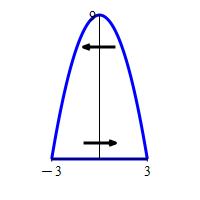9. Line Integrals
Homework
-
A wire has the shape of the parametric curve \(\vec r(t)=\left\langle\dfrac{1}{2}t^2+1,t-2,\dfrac{2\sqrt{2}}{3}t^{3/2}\right\rangle\) from \(t=0\) to \(t=4\) with linear mass density \(\delta=y+2\).
-
Find the length of the wire.
-
Find the total mass.
-
Find the \(y\)-component of the center of mass.
-
Find the average value of the function \(f(x,y,z)=(x-1)(y+2)\).
-
-
Compute the integral \(\displaystyle \int_{(0,0,0)}^{(1,\sqrt{3/2\,},1)} xz\,ds\) along the twisted cubic \(\vec r(t)=\left(t,\sqrt{\dfrac{3}{2}}t^2,t^3\right)\).
-
Find the mass of the cusp \(x^3=y^2\) for \(0 \le x \le \dfrac{1}{9}\) if the linear density is \(\delta=x\). The cusp may be parametrized as \(\vec r(t)=(t^2,t^3)\).
-
Find the work done by the force \(\vec F=\langle 2z^2,2yz,5xz\rangle\) on an object which moves along the curve \(\vec r=(t^3,t^2,t)\) between \(P=(1,1,1)\) and \(Q=(8,4,2)\).
-
Compute \(\displaystyle \int_{(0,4,0)}^{(6\pi,4,0)} \left[\rule{0pt}{10pt}(y+z)\,dx+z\,dy-y\,dz\right]\) along the helix \(\vec r=\langle3t, 4\cos(2t), 4\sin(2t)\rangle\).
-
Find the flow of the velocity field \(\vec V=(2xz,xy,-4y)\) along the twisted cubic \(\vec r(t)=(t,t^2,t^3)\) from \((1,1,1)\) to \((2,4,8)\). Is the fluid flowing in the same or opposite direction as the curve is traversed?
-
Find the circulation of the velocity field \(\vec V=(-y^3,xy^2)\) counterclockwise around the circle \(x^2+y^2=4\). Does the fluid flow clockwise or counterclockwise?
-
Find the circulation of the magnetic field \(\vec B=(x^2,x+y,0)\) counterclockwise along the line segment \(y=0\) from \(x=-3\) to \(x=3\) and around the parabola \(y=9-x^2\) from \(x=3\) to \(x=-3\). Does the magnetic field circulate clockwise or counterclockwise?

Heading
Placeholder text: Lorem ipsum Lorem ipsum Lorem ipsum Lorem ipsum Lorem ipsum Lorem ipsum Lorem ipsum Lorem ipsum Lorem ipsum Lorem ipsum Lorem ipsum Lorem ipsum Lorem ipsum Lorem ipsum Lorem ipsum Lorem ipsum Lorem ipsum Lorem ipsum Lorem ipsum Lorem ipsum Lorem ipsum Lorem ipsum Lorem ipsum Lorem ipsum Lorem ipsum